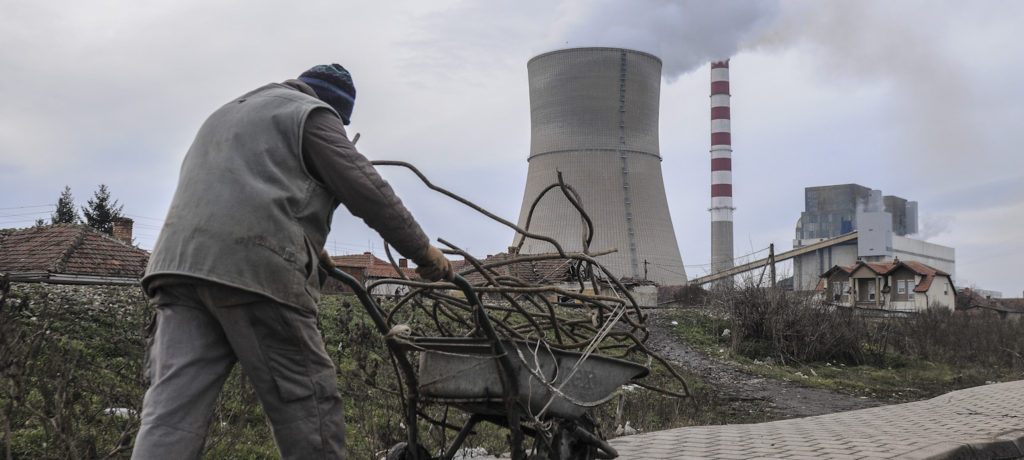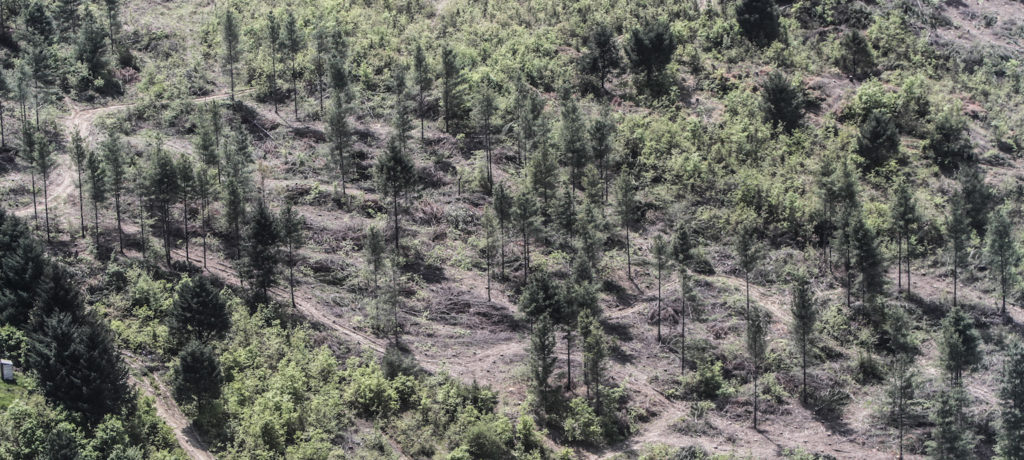Editorial note: This article was originally published in Kosovo 2.0’s Green Issue print magazine in 2015.
“I have woken up and cursed that power plant a million times,” Driton Berisha said in an interview with British newspaper The Guardian, published in October 2013. Driton was quoted as saying that almost everyone he knows, including his own mother, has a family member who is battling some form of cancer or respiratory disease. His anguished words are not just a figment of his imagination, and he is not a deluded man stricken with some creeping paranoia when he assumes that the air is killing everybody around him. He just happens to be living in Plemetina, a small town among a cluster of villages unfortunate enough to be in the front lines of the colossal monster-chimneys of Kosovo power plants, billowing out smoke, ash and disease.
But it’s not just Driton’s hometown under the reign of gloom; it is the big blue sky over Europe’s youngest country that is vanishing under dense and lingering clouds. They descend slowly, coating the land in acrid dust and hoary smoke, like the whole place is trying to overcome the effects of some cataclysmic event in the sky.
The outdoor air in Kosovo is a slow killer. It’s laden with deadly pollutants like sulfur dioxide and nitrogen oxide — two particularly poisonous air toxins — which are responsible for qualifying the air there as Europe’s worst. The most dangerous places to breathe in Kosovo are cities and urban areas, where the prevalence of cancer, pulmonary and respiratory diseases are some of the leading causes of hospitalization, illness and death in the country.
In one of its most comprehensive environmental analyses in Kosovo, the World Bank reckons that air pollution causes over 800 premature deaths, 300 cases of bronchitis, and over 11,000 hospital emergency visits. No one knows exactly how many people battle the effects of poor health without seeking medical attention. This ongoing disaster imposes staggering costs to the already feeble public health system in Kosovo, with estimates going as high as 158 million euro — an equivalent of 4 percent of the country’s gross domestic product.
The biggest culprits for this carnage are power plants and coal mines, the burning of wood and lignite, industrial polluters (such as Trepca), public heaters, the fume-filled roads, and industrial and municipal landfill waste. In Kosovo’s rapid environmental degradation, outdoor air pollution is the most acute problem and the deadliest. The levels of pollution are especially frightening in urban areas like Prishtina, Obiliq and Mitrovica, with observed air quality exceeding all European limits of pollutant levels.
Along with air pollution, lead contamination is the second-most serious and costly environmental pollutant in Kosovo. Lead is discarded from mines, such as coal and zinc, and it can also be found in gasoline and fuel used in cars and other motorized vehicles. Here, too, estimated costs from lead contamination reach 100 million euro.
Air pollution has always been considered a major environmental challenge for public health in many countries, but the issue has taken a more serious turn since October 2013, when the World Health Organization (WHO) classified air pollution as a cancer-causing agent. The International Agency for Research on Cancer (IARC), a research arm of WHO, released a blunt assessment that outdoor air pollution causes lung cancer and poses high risks for bladder cancer. The head of the IARC Monograph section referred to outdoor air pollution as “the most important environmental cancer killer due to the large number of people exposed.” In addition, IARC classifies all outdoor air pollutants as carcinogenic, including diesel engine exhaust, dust, and various metals that circulate in the air. It is no wonder then that the people around Driton Berisha and many other Kosovars have such a high incidence of respiratory diseases and cancer.
Mitigating the deadly effects of air pollution is the most urgent need, especially in urban areas where the problem is acute. Studies have shown that emitted dust is the main particle in the air that has a direct detrimental effect on health. According to the World Bank environmental study, 78 percent of the fine dust emitted in Kosovo comes from KEK’s power plants, the majority of which is directly from Kosovo. Given the physical proximity to the power plants, Prishtina and its surroundings are the most affected by dust emissions. One suggested way to mitigate the effect that dust has on public health is to control the production of ash and employ technological solutions for gas treatment. The World Bank estimates that reducing the current levels of dust by about 10 percent would cost Kosovo approximately 34 million euro. Gas treatment, which would address the problem of nitrogen oxides and sulfur dioxide, would cost another 50 million euro for both power plants.
On the road
Beyond the pollution caused by these power plants and other industrial complexes such as Ferronikeli, transportation is also a leading contributor to air pollution. In the European Union, vehicle emissions are strictly enforced, but such regulations apply only to new vehicles. This means that old vehicles may not possess the technology to control emission of particles in the air. This is a problem in Kosovo because the majority of the country’s imports of second-hand cars come from the European Union. Reducing vehicle emissions in Kosovo then requires a strategy to deal with the old stock of vehicles, as most of the approximately 390,000 vehicles on the road (as of 2009) belong in this category.
Technical measures to mitigate emissions vary and include the installation of filters and other converters to control emitted particles, as well as effectively dealing with lead content in gasoline. The most important could be adopting a strategy that limits the use of private cars by adopting effective public transportation policies and reducing private vehicle use in urban areas. Many cities that deal with air pollution have found ways to create public policies that mitigate the negative impact of vehicle emissions; examining some of these studies may yield ideas that could be practical and sensible for adoption in Kosovo.
While air pollution from industrial power plants and traffic is the deadliest form of environmental degradation in the new country, it is not the only issue that Kosovars face in their living environment. Kosovo has some of the highest rates of municipal waste production in Europe. Different from industrial waste, municipal waste is generated mostly from households, as well as small shops and businesses, which are often mixed together. In the European Union, municipal waste accounts for an estimated 10 percent, but that number is much higher in Kosovo. According to Kosovo’s own Environmental Agency’s 2012 annual report, the country generated 334 kilograms of waste per person per year. The average for the European Union in the same year was 492 kilograms per person. This may look like Kosovo is under the average, but the problem here is also with collection rates. EU countries’ waste collection covers 97 percent of the population, compared to about 41 percent in Kosovo.
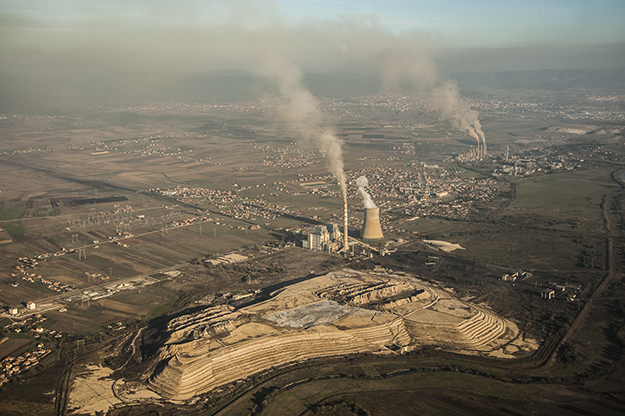
KEK’s power plants produce the majority of Kosovo’s fine dust emissions. Prishtina is particularly vulnerable due to its proximity to them. Photo: Atdhe Mulla
The issue of waste generation has only gotten worse over the last few years. While the municipal waste generated in the EU fell by 5 percent between 2007 and 2012, Kosovo increased its own by 100 percent from 2008 to 2012. Since the collection rate in terms of population covered hasn’t changed much, this would suggest that Kosovars are generating waste at a faster rate than any time since data collection began. This also explains why the current average of 334 kilograms waste generated per person may not be a proper estimate. In fact, this is misleading because if more than 90 percent of the population were to be covered, the average waste generation would increase substantially, possibly surpassing regional and EU averages. This would put Kosovo in category with one of Europe’s highest rates of waste generation on per capita basis.

Every year in Kosovo, an estimated 13 children under the age of 5 die because of water contamination and poor hygiene. Children are particularly vulnerable to waterborne diseases such as diarrhea. Photo: Visar Kryeziu.
High rates of waste generation are often seen as a byproduct of wealth and consumption; rich countries generate more waste per person than poor ones. Denmark, for example, generated 668 kilograms of waste per person in 2012, Germany 611, and France 534. But these countries have also developed some of the best methods of treating waste, where less than 3 percent of generated waste is disposed in landfills — the worst form of waste treatment. Over 95 percent of waste generated in these countries is recycled, composted or incinerated in controlled environments. By contrast, over 95 percent of Kosovo’s waste ends up in landfills, most of which do not even meet the standards of modern landfills. Again, almost 60 percent of people in Kosovo are not covered by waste collection. This means that all the waste generated in this group goes uncollected, ending up in the streets and the surrounding environment. Illegal dumping pollutes water streams and food, spreading disease, choking life and harming biodiversity in plants and animals.
Fouling the waters
All rivers in Kosovo are classified as polluted sources of water due to untreated sewage, inadequate waste disposal and other forms of waste dumping. As with air pollution, industrial polluters, including KEK, Ferronikeli, Trepca and other industrial complexes, play a leading role in water contamination by releasing heavy metals such as lead and cadmium, a toxic chemical element that is listed in the European Union’s Restriction of Hazardous Substances. Apart from industrial polluters, agriculture also plays a significant role in polluting water sources where management of manure is largely absent. Livestock manure, for example, contributes to approximately 19,000 tons of nitrogen per year, with most of it ending in water streams. The contamination of water resources leads to various waterborne diseases, the most serious of which is diarrhea — and children are especially vulnerable to the disease. Using methodologies created by the WHO, the World Bank estimates that in Kosovo about 13 children under the age of 5 die every year as a result of water contamination and poor hygiene. The total impact of water contamination and poor hygiene and water supply costs Kosovo over 30 million euro, but more accurate measures of long term public health and environmental consequences are unknowable.
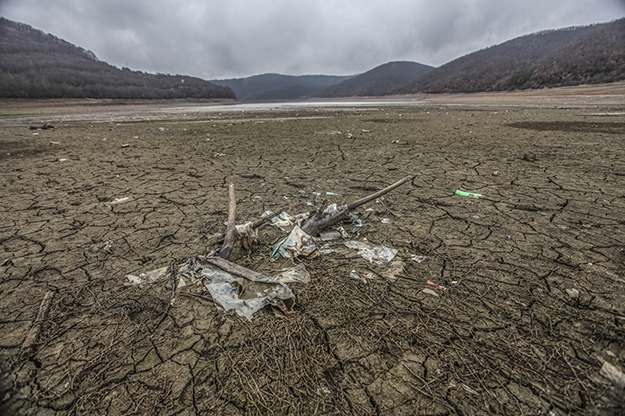
The illegal dumping of waste contributes to water contamination such as here at lake Badovc; all of Kosovo’s rivers are classified as polluted sources of water. Photo: Kushtrim Ternava.
Beyond the grey ash that floats in the air, polluted streams and rivers, as well as strewn industrial and municipal waste, the trees are vanishing from Kosovo’s forests. The disappearance of forests might be one of the saddest stories in the degradation of the natural habitat in Kosovo, especially considering that it takes decades to regenerate lost trees. Deforestation by illegal logging, fires and other forms of destruction has reduced many areas of forests and woodlands of Kosovo into sad and bare-looking slopes of shrubs and bushes. By its own reckoning, Kosovo’s Ministry of Agriculture, Forestry and Rural Development calculates that despite the disappearance of forests, only 0.5 percent of it is replanted using cultivation. Illegal woodcutting is one of the most pernicious in destroying woodland, with more than 40 percent of public forests being cut illegally. The root cause for this is primarily economic in nature, where poverty and poor economic conditions have led to more than 95 percent of illegal wood being used as firewood for household heating. The World Bank estimates that the annual cost of environmental degradation with respect to deforestation reaches over 19 million euro.
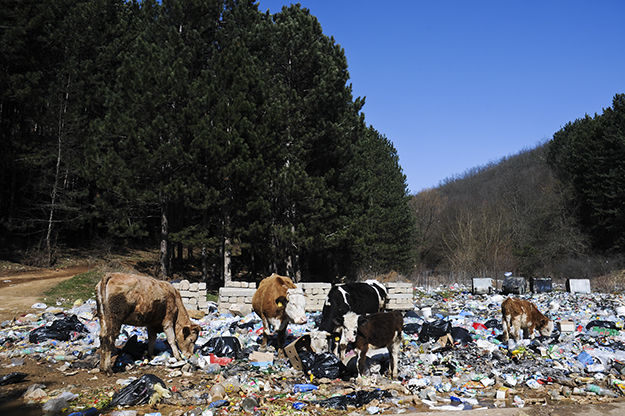
Kosovo’s waste production has increased by 100 percent in recent years, while waste production in the EU has fallen. Photo: Kushtrim Ternava
In the end, environmental degradation in Kosovo is not limited only to outdoor air pollution and waste, but extends to other areas such as land misuse and contamination, destruction of small ecosystems, and the endangerment and killing of wildlife. To mitigate and start reversing the effects of this mindless destruction, Kosovo government — both central and local — needs to engage in a systematic campaign of public education, regulation, enforcement and investment. There is no single method or policy action that would be able to start reversing the harmful trends on so many levels. A multi-year and multi-dimensional approach with significant resources and investments is needed to address some of the above issues, but government alone will not be able to tackle the multitude of environmental problems that the country faces. Other organizations and institutions, including private sector, NGOs, think tanks, environmental organizations, as well as ordinary Kosovars, would need to participate in the effort in order to have an effect and start reversing the trend that is costing Kosovo so much in money and lives.K
Feature image: Visar Kryeziu.

